- Yet we have so disconnected ourselves from the natural world that it is easy—and often convenient—to forget that nature remains as giving as ever, even as it vanishes bit-by-bit.
- The rise of technology and industry may have distanced us superficially from nature, but it has not changed our reliance on the natural world: most of what we use and consume on a daily basis remains the product of multitudes of interactions within nature, and many of those interactions are imperiled.
- Beyond such physical goods, the natural world provides less tangible, but just as important, gifts in terms of beauty, art, and spirituality.
Rainforest leaves in Uganda. Photo by: Rhett A. Butler.
To read last year’s Earth Day article: World failing on every environmental issue: an op-ed for Earth Day.
There is no question that Earth has been a giving planet. Everything humans have needed to survive, and thrive, was provided by the natural world around us: food, water, medicine, materials for shelter, and even natural cycles such as climate and nutrients. Scientists have come to term such gifts ‘ecosystem services’, however the recognition of such services goes back thousands of years, and perhaps even farther if one accepts the caves paintings at Lascaux as evidence. Yet we have so disconnected ourselves from the natural world that it is easy—and often convenient—to forget that nature remains as giving as ever, even as it vanishes bit-by-bit. The rise of technology and industry may have distanced us superficially from nature, but it has not changed our reliance on the natural world: most of what we use and consume on a daily basis remains the product of multitudes of interactions within nature, and many of those interactions are imperiled. Beyond such physical goods, the natural world provides less tangible, but just as important, gifts in terms of beauty, art, and spirituality.
Earth Day seems as good a day as any to remind ourselves what nature gives us free-of-charge. Here then is a selective sampling of nature’s importance to our lives:
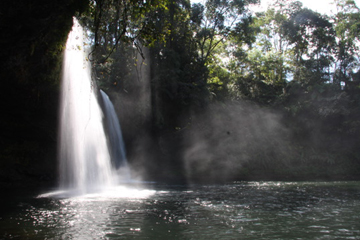 Tad lo waterfall in Laos. Photo by: Rhett A. Butler. |
Fresh water: There is no physical substance humans require more than freshwater: without water we can only survive a few hellish days. While pollution and overuse has threatened many of the world’s drinking water sources, nature has an old-fashioned solution, at least, to pollution. Healthy freshwater ecosystems—watersheds, wetlands, and forests—naturally clean pollution and toxins from water. Soils, microorganisms, and plant roots all play a role in filtering and recycling out pollutants with a price far cheaper than building a water filtration plant. According to research, the more biodiverse the ecosystem, the faster and more efficiently water is purified.
Pollination: Imagine trying to pollinate every apple blossom in an orchard: this is what nature does for us. Insects, birds, and even some mammals, pollinate the world’s plants, including much of human agriculture. Around 80% of the world’s plants require a different species to act as pollinator.
In agriculture, pollinators are required for everything from tomatoes to cocoa, and almonds to buckwheat, among hundreds of other crops. Globally, agricultural pollination has been estimated to be worth around $216 billion a year. However large such monetary estimates don’t include pollination for crops consumed by livestock, biofuels, ornamental flowers, or the massive importance of wild plant pollination.
Seed dispersal: Much like pollination, many of the world’s plants require other species to move their seeds from the parent plant to new sprouting ground. Seeds are dispersed by an incredibly wide-variety of players: birds, bats, rodents, megafauna like elephants and tapir, and even, researchers have recently discovered, fish. Seed dispersal is especially important for tropical forests where a majority of plants depend on animals to move.
Pest control: A recent study found that bats save US agriculture billions of dollars a year simply by doing what they do naturally: eating insects, many of which are potentially harmful to US crops.
Almost all agricultural pests have natural enemies, along with bats, these include birds, spiders, parasitic wasps and flies, fungi, and viral diseases. The loss, or even decline, of such pest-eating predators can have massive impacts on agriculture and ecosystems.
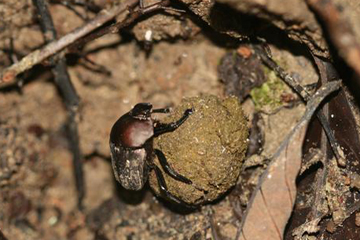 The world’s dung beetles have a dirty job, but someone has to do it: feeding exclusively on feces dung beetles play a big role in nutrient and soil recycling. This beetle was photographed in Malaysian Borneo. Photo by: Rhett A. Butler. |
Soil health: The ground under our feet matters more than we often admit. Healthy fertile soil provides optimal homes for plants, while participating in a number of natural cycles: from recycling nutrients to purifying water. Although soil is renewable, it is also sensitive to overuse and degradation often due to industrial agriculture, pollution, and fertilizers. Natural vegetation and quality soil also mitigates excessive erosion, which can have dramatic impacts from loss of agricultural land to coastlines simply disappearing into the sea.
Medicine: Nature is our greatest medicine cabinet: to date it has provided humankind with a multitude of life-saving medicines from quinine to aspirin, and from morphine to numerous cancer and HIV-fighting drugs. There is no question that additionally important medications—perhaps even miracle cures—lie untapped in the world’s ecosystems. In fact, researchers estimate that less than 1% of the world’s known species have been fully examined for their medicinal value. However the ecosystems that have yielded some of the world’s most important and promising drugs—such as rainforests, peat swamps, and coral reefs—are also among the most endangered. Preserving ecosystems and species today may benefit, or even save, millions of lives tomorrow.
Fisheries: Humankind has turned to the rivers and seas for food for at least 40,000 years but probably even longer. Today, amid concern of a global fishery collapse, more than a billion people depend on fish as their primary source of protein, many of them among the global poor. Fisheries also provide livelihoods, both directly and indirectly, for around half a billion. Coral reefs, mangroves, and seagrass ecosystems provide nurseries for the world’s fisheries, while the open ocean is used for migrating routes and hunting.
Even with the direct importance of the world’s fisheries for food, stewardship has been lacking, allowing many populations to drop precipitously and still permitting ecologically destructive fishing. While the world’s fisheries are primarily threatened by overfishing, including bycatch, marine pollution is also a major problem.
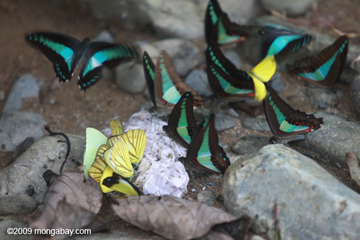 In the hugely imperiled tropical rainforests of Sumatra, diverse species of butterflies feed on ground nutrients. Photo by: Rhett A. Butler. |
Biodiversity and wildlife abundance: The argument to save the world’s wildlife has often come from an aesthetic point of view. Many conservationists have fought to save species simply because they like a particular species. This is often why more popularly known animals—tigers, elephants, rhinos—receive far more attention than less popular (although just as endangered) wildlife—for example, the redbelly egg frog, the smokey bat, or the bastard quiver tree. But beyond making the world a less lonely, less boring, and less beautiful place—admirable reasons in themselves—many of the services provided by biodiversity are similar to those provided by all of nature. Biodiversity produces food, fibers, wood products; it cleans water, controls agricultural pests, pollinates and dispersers the world plants; and provides recreation, such as birdwatching, gardening, diving, and ecotourism.
In the discussion of biodiversity, however, bioabundance is often ignored. A loss in bioabundance means that species are not just important for their diversity, but for their numbers. While Asian elephants may not go extinct any time soon, their depletion in forests means that the ecosystems lose the elephants’ special ecological talents such as spreading seeds and engineering micro-habitats. The drop in salmon populations in the US has caused the entire freshwater ecosystem to receive less nutrients every year (researchers estimate a nutrient-drop of over 90 percent); this means less food for people, less salmon for predators, and a less rich river overall. Declining nutrients also makes it impossible for the salmon to rebound to optimal populations, creating a vicious circle of bio-decline.
Climate regulation: The natural world helps regulate the Earth’s climate. Ecosystems such as rainforests, peatlands, and mangroves store significant amounts of carbon, while the ocean captures massive amounts of carbon through phytoplankton. While regulating greenhouse gases are imperative in the age of climate change, new research is showing that the world’s ecosystems may also play a role in weather. A recent study found that the Amazon rainforest acted as its own ‘bioreactor’, producing clouds and precipitation through the abundance of plant materials in the forest.
Economy: In the common tension viewed between the economy and the environment—e.g. do we clear-cut a forest or conserve it?—one fact is often neglected: the environment underpins the entire global economy. Without fertile soils, clean drinking water, healthy forests, and a stable climate, the world’s economy would face disaster. By imperiling our environment, we imperil the economy. According to research published in Science, the global worth of total ecosystem services could run between $40-60 trillion a year.
Health: Recent research has found what nature-lovers have long expected: spending time in a green space, such as a park, provides benefits for one’s mental and physical health. Exercising in a park, instead of inside a gym, has shown to provide mental health benefits as a greater sense of well-being. Walking for 20 minutes in a green space has been proven to help children with ADHD improve their concentration, even working as well, or better, than medication. People who live in more natural settings have better overall health, even when research has taken into account economic differences.
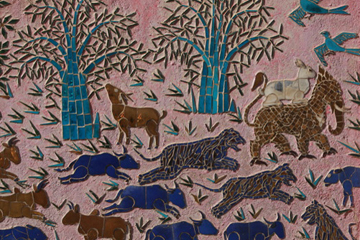 Mosaic artwork of wildlife in Buddhist temple in Laos. Nature has inspired both art and religion around the world. Photo by: Rhett A. Butler. |
Art: Imagine poetry without flowers, painting without landscapes, or film without scenery. Imagine if Shakespeare had no rose to compare Juliet to, or if William Blake had no Tyger to set alight. Imagine if Van Gogh lacked crows to paint or Durer a rhinoceros to cut. What would the Jungle Book be without Baloo or the Wind in the Willows without Mr. Badger? Imagine My Antonia without the red grass of the American prairie or Wuthering Heights without the bleak moors. How would The Lord of the Rings film series appear without the stunning mountain ranges of New Zealand, or Lawrence of Arabia without the desert of North Africa? There is no question that the natural world has provided global arts with some of its greatest subjects. What we lose in nature, we also lose in art.
Spiritual: While some of what nature provides us is measurable, most of what nature gives us is simply beyond measure. Economic measurements are useful; but as with most of what happens in the world, economics is simply incapable of capturing true worth. Science is also a useful measurement regarding the importance of nature, but once again cannot measure what nature means—practically and aesthetically—to each individual.
Perhaps the most difficult gift of nature’s to measure is its ingrained connection to human spirituality. In most of the world’s religions the natural world is rightly revered. In Christianity, Earthly paradise existed in a garden, while Noah, the original conservationist, is commanded by God to save every species. Buddhists believe all life—from the smallest fly to the blue whale—is sacred and worthy of compassion. For Hindus every bit of the natural world is infused with divinity. Muslims believe the natural world was created by Allah and only given to humans as gift to be held in trust. Indigenous cultures worldwide celebrate the natural world as their ‘mother’.
But one need not be religious to understand the importance of nature to the human spirit: one only need spend time alone in a shadowy forest, sit on a forgotten beach, touch the spine of a living frog, or watch the quarter moon swing behind mountain silhouettes.

A church rests in the shadows of mountains in Madagascar’s Tsaranoro Valley. Photo by: Rhett Butler.
Related articles
World failing on every environmental issue: an op-ed for Earth Day
 (04/22/2010) The biodiversity crisis, the climate crisis, the deforestation crisis: we are living in an age when environmental issues have moved from regional problems to global ones. A generation or two before ours and one might speak of saving the beauty of Northern California; conserving a single species—say the white rhino—from extinction; or preserving an ecological region like the Amazon. That was a different age. Today we speak of preserving world biodiversity, of saving the ‘lungs of the planet’, of mitigating global climate change. No longer are humans over-reaching in just one region, but we are overreaching the whole planet, stretching ecological systems to a breaking point. While we are aware of the issues that threaten the well-being of life on this planet, including our own, how are we progressing on solutions?
(04/22/2010) The biodiversity crisis, the climate crisis, the deforestation crisis: we are living in an age when environmental issues have moved from regional problems to global ones. A generation or two before ours and one might speak of saving the beauty of Northern California; conserving a single species—say the white rhino—from extinction; or preserving an ecological region like the Amazon. That was a different age. Today we speak of preserving world biodiversity, of saving the ‘lungs of the planet’, of mitigating global climate change. No longer are humans over-reaching in just one region, but we are overreaching the whole planet, stretching ecological systems to a breaking point. While we are aware of the issues that threaten the well-being of life on this planet, including our own, how are we progressing on solutions?
More biodiversity equals cleaner water, but why?
(04/07/2011) A new landmark study not only proves that adding more species to a freshwater stream linearly increases the ecosystem’s ability to clean pollutants, but also shows why. The study, published in Nature found that by increasing the biodiversity of a lab controlled mini-stream from one algae species to eight caused the ecosystem to soak up nitrate pollution 4.5 times faster on average. To conduct the experiment, researchers used plastic to create 150 mini model streams. Molding the plastic, they recreated real stream-like habitats such as pools, runs, and eddies. Different species of algae gravitated toward particular mini-habitats, creating special ecological niches and allowing more of the stream to be utilized by the algae for soaking up the nitrate pollution. Less utilization of the available habitats resulted in a dirtier river and vice-versa.
The value of the little guy, an interview with Tyler Prize-winning entomologist May Berenbaum
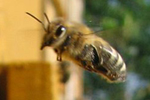 (04/06/2011) May Berenbaum knows a thing or two about insects: in recognition of her lifelong work on the interactions between insects and plants, she has had a character on The X-Files named after her, received the Public Understanding of Science and Technology Award for her work in making science accessible to the public, and this year has been awarded the prestigious Tyler Environmental Prize. “Winning the Tyler Prize is an incredible honor—most of my scientific heroes have been Tyler Prize winners and I’m exceedingly grateful to be considered worthy of being included among their ranks,” Berenbaum told mongabay.com in an interview. “The Prize is also tremendously enabling—because the money is unrestricted I can use it to carry out projects that have been difficult to fund.”
(04/06/2011) May Berenbaum knows a thing or two about insects: in recognition of her lifelong work on the interactions between insects and plants, she has had a character on The X-Files named after her, received the Public Understanding of Science and Technology Award for her work in making science accessible to the public, and this year has been awarded the prestigious Tyler Environmental Prize. “Winning the Tyler Prize is an incredible honor—most of my scientific heroes have been Tyler Prize winners and I’m exceedingly grateful to be considered worthy of being included among their ranks,” Berenbaum told mongabay.com in an interview. “The Prize is also tremendously enabling—because the money is unrestricted I can use it to carry out projects that have been difficult to fund.”
Vanishing mangroves are carbon sequestration powerhouses
(04/05/2011) Mangroves may be the world’s most carbon rich forests, according to a new study in Nature Geoscience. Measuring the carbon stored in 25 mangrove forests in the Indo-Pacific region, researchers found that mangroves forests stored up to four times as much carbon as other tropical forests, including rainforests. “Mangroves have long been known as extremely productive ecosystems that cycle carbon quickly, but until now there had been no estimate of how much carbon resides in these systems. That’s essential information because when land-use change occurs, much of that standing carbon stock can be released to the atmosphere,” explains co-author Daniel Donato, a postdoctoral research ecologist at the Pacific Southwest Research Station in Hilo, Hawaii.
(04/03/2011) US agriculture stands to lose billions in free ecosystem services from the often-feared and rarely respected humble bat. According to a recent study in Science bats in North America provide the US agricultural industry at least $3.7 billion and up to a staggering $53 billion a year by eating mounds of potentially pesky insects. Yet these bats, and their economic services, are under threat by a perplexing disease known as white-nose syndrome (WNS) and to a lesser extent wind turbines.
‘Huge reduction’ of water from plants due to higher carbon levels
(03/30/2011) As if ocean acidification and a warming world weren’t enough, researchers have outlined another way in which carbon emissions are impacting the planet. A new study shows that higher carbon dioxide levels in the atmosphere have taken a toll on how much water vapor plants release, potentially impacting the rainfall and groundwater sources. A study in the Proceedings of the National Academy of Sciences (PNAS) has found that carbon dioxide levels over the past 150 years has reduced plants’ spores, called stomata, by over one third (34%). This is important because stomata take in oxygen and carbon dioxide and release water vapor in a process dubbed ‘transpiration’. Less stomata means less water driven into the atmosphere.
(03/21/2011) The UN-backed Collaborative Partnership on Forests (CPF) is urging nations to conserve their forests in a bid to mitigate rising water scarcity problem.
Rich plant diversity leads to increased productivity, ecosystem services
(03/08/2011) A new study finds that diversity of plant species matters—big time. Analyzing nearly 600 research studies, the meta-study in the American Journal of Botany found that productivity in biodiverse plant ecosystems was 1.5 times higher than in monocultures. In other words, a prairie is more productive than a cornfield and forest more productive than a rubber plantation. The researchers warn that eroding plant diversity threatens essential ecosystems services such as food, water purification, oxygen production, carbon sequestration, and the availability of raw materials.
World’s sixth mass extinction still preventable

(03/03/2011) So, here’s the good news: a mass extinction, the world’s sixth, is still preventable. But the bad news: if species currently threatened with extinction vanish—even over the next thousand years—homo-sapiens will be the first single species responsible for a mass extinction. Comparing today’s current extinction crisis with the big five that occurred in the past, a new study in Nature finds that while the situation is dire, the choice is ultimately up to humanity. “If you look only at the critically endangered mammals—those where the risk of extinction is at least 50 percent within three of their generations—and assume that their time will run out, and they will be extinct in 1,000 years, that puts us clearly outside any range of normal, and tells us that we are moving into the mass extinction realm,” explains lead author Anthony D. Barnosky, UC Berkeley professor of integrative biology.
Coral crisis: 75% of the world’s coral reefs in danger
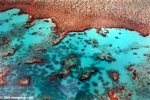 (02/23/2011) Marine scientists have been warning for years that coral reefs, the most biodiverse ecosystems in the ocean, are facing grave peril. But a new comprehensive analysis by the World Resources Institute (WRI) along with twenty-five partners ups the ante, finding that 75% of the world’s coral reefs are threatened by local and global impacts, including climate change. An updating of a 1996 report, the new analysis found that threats had increased on 30% of the world’s reefs. Clearly conservation efforts during the past decade have failed to save reefs on a large-scale.
(02/23/2011) Marine scientists have been warning for years that coral reefs, the most biodiverse ecosystems in the ocean, are facing grave peril. But a new comprehensive analysis by the World Resources Institute (WRI) along with twenty-five partners ups the ante, finding that 75% of the world’s coral reefs are threatened by local and global impacts, including climate change. An updating of a 1996 report, the new analysis found that threats had increased on 30% of the world’s reefs. Clearly conservation efforts during the past decade have failed to save reefs on a large-scale.
South Sudan’s choice: resource curse or wild wonder?
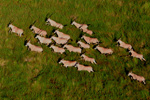 (02/11/2011) After the people of South Sudan have voted overwhelmingly for independence, the work of building a nation begins. Set to become the world’s newest country on July 9th of this year, one of many tasks facing the nation’s nascent leaders is the conservation of its stunning wildlife. In 2007, following two decades of brutal civil war, the Wildlife Conservation Society (WCS) surveyed South Sudan. What they found surprised everyone: 1.3 million white-eared kob, tiang (or topi) antelope and Mongalla gazelle still roamed the plains, making up the world’s second largest migration after the Serengeti. The civil war had not, as expected, largely diminished the Sudan’s great wildernesses, which are also inhabited by buffalo, giraffe, lion, bongo, chimpanzee, and some 8,000 elephants. However, with new nationhood comes tough decisions and new pressures. Multi-national companies seeking to exploit the nation’s vast natural resources are expected to arrive in South Sudan, tempting them with promises of development and economic growth, promises that have proven uneven at best across Africa.
(02/11/2011) After the people of South Sudan have voted overwhelmingly for independence, the work of building a nation begins. Set to become the world’s newest country on July 9th of this year, one of many tasks facing the nation’s nascent leaders is the conservation of its stunning wildlife. In 2007, following two decades of brutal civil war, the Wildlife Conservation Society (WCS) surveyed South Sudan. What they found surprised everyone: 1.3 million white-eared kob, tiang (or topi) antelope and Mongalla gazelle still roamed the plains, making up the world’s second largest migration after the Serengeti. The civil war had not, as expected, largely diminished the Sudan’s great wildernesses, which are also inhabited by buffalo, giraffe, lion, bongo, chimpanzee, and some 8,000 elephants. However, with new nationhood comes tough decisions and new pressures. Multi-national companies seeking to exploit the nation’s vast natural resources are expected to arrive in South Sudan, tempting them with promises of development and economic growth, promises that have proven uneven at best across Africa.
Prince Charles: ‘direct relationship’ between ecosystems and the economy
(02/09/2011) At an EU meeting in Brussels, dubbed the Low Carbon Prosperity Summit, the UK’s Prince Charles made the case that without healthy ecosystems, the global economy will suffer.
The ocean crisis: hope in troubled waters, an interview with Carl Safina
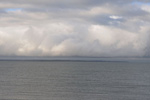
(02/07/2011) Being compared—by more than one reviewer—to Henry Thoreau and Rachel Carson would make any nature writer’s day. But add in effusive reviews that compare one to a jazz musician, Ernest Hemingway, and Charles Darwin, and you have a sense of the praise heaped on Carl Safina for his newest work, The View from Lazy Point: A Natural Year in an Unnatural World. Like Safina’s other books, The View from Lazy Point focuses on the beauty, poetry, and crisis of the world’s oceans and its hundreds-of-thousands of unique inhabitants. Taking the reader on a journey around the world—the Arctic, Antarctic, and the tropics—Safina always returns home to take in the view, and write about the wildlife of his home, i.e. Lazy Point, on Long Island. While Safina’s newest book addresses the many ways in which the ocean is being degraded, depleted, and ultimately imperiled as a living ecosystem (such as overfishing and climate change) it also tweezes out stories of hope by focusing on how single animals survive, and in turn how nature survives in an increasingly human world. However, what makes Safina’s work different than most nature writing is his ability to move seamlessly from contemporary practical problems to the age-old philosophical underpinnings that got us here. By doing so, he points a way forward.
From Cambodia to California: the world’s top 10 most threatened forests
 (02/02/2011) Growing populations, expanding agriculture, commodities such as palm oil and paper, logging, urban sprawl, mining, and other human impacts have pushed many of the world’s great forests to the brink. Yet scientists, environmentalists, and even some policymakers increasingly warn that forests are worth more standing than felled. They argue that by safeguarding vulnerable biodiversity, sequestering carbon, controlling erosion, and providing fresh water, forests provide services to humanity, not to mention the unquantifiable importance of having wild places in an increasingly human-modified world. Still, the decline of the world’s forests continues: the FAO estimating that around 10 million hectares of tropical forest are lost every year. Of course, some of these forests are more imperiled than others, and a new analysis by Conservation International (CI) has catalogued the world’s 10 most threatened forests.
(02/02/2011) Growing populations, expanding agriculture, commodities such as palm oil and paper, logging, urban sprawl, mining, and other human impacts have pushed many of the world’s great forests to the brink. Yet scientists, environmentalists, and even some policymakers increasingly warn that forests are worth more standing than felled. They argue that by safeguarding vulnerable biodiversity, sequestering carbon, controlling erosion, and providing fresh water, forests provide services to humanity, not to mention the unquantifiable importance of having wild places in an increasingly human-modified world. Still, the decline of the world’s forests continues: the FAO estimating that around 10 million hectares of tropical forest are lost every year. Of course, some of these forests are more imperiled than others, and a new analysis by Conservation International (CI) has catalogued the world’s 10 most threatened forests.
U.S. bumble bees experiencing significant declines
(01/04/2011) Many US bumble bee populations have declined significantly over the past few decades, with certain species dropping off by as much as 96%. While the decline is linked to low genetic diversity and disease, an underlying cause remains uncertain.








